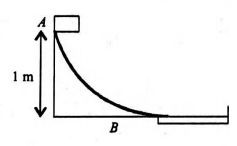Q.
A block weighing $10\, N$ travels down a smooth curved track $A B$ joined to a rough horizontal surface (see figure). The rough surface has a friction coefficient of $0.20$ with the block. If the block starts slipping on the track from a point $1.0\, m$ above the horizontal surface, then it would move a distance $s$ on the rough surface. The value of $s$ is $\left[g=10 \,ms ^{-2}\right]$
Work, Energy and Power
Solution: